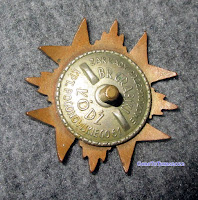Some time ago, I wrote a post about the Kordzik family - Henry, Augusta, and their children, including Alfred. Today, more about him.
Alfred Konrad Kordzik was born on 30 November 1887, in Fredericksburg, TX (1), to Henry Kordzik (age 50) and Augusta Mayer (age 37). The boy was their youngest son.
By 1900, little Alfred, his parents, and his siblings had lived in justice Precinct #1, Gillespie, TX (2).
Alfred Konrad was confirmed on 23 March 1902 at the Holy Ghost Lutheran Church by Pastor Gustav Hone.
About twenty years later, during the 1910 census, the family was recorded in the Cave Creek area, Gillespie, TX (3). Only Alfred and his younger sister Meta lived in the home of their parents then. Their elder siblings had already left the family home.
22-year-old Alfred started his own family in the very same year, on 7 June. He married a few months younger Miss Cora Auguste Moellering (4). She was born on 23 February 1888 to Heinrich and Louise Moellering.
Cora and Alfred lived in Justice Precinct #1, Gillespie, TX. Alfred was a farmer like his father (5).
WW1 time - Alfred was registered by the Army (6). The man was exempted from the service as he was the only supporter of his wife Cora.
31 May 1928 - Alfred's father passed. Two years later, on 24 June, his mother Auguste died.
Census 4 April 1950, Alfred (age 62) ranched in Fredericksburg, and Cora helped him with the ranch work (7).
Alfred's time came on 21 October 1968. He died in the Nix Memorial Hospital in San Antonio, where he had been treated for four weeks (8).
More about Alfred's parents and siblings:
Kordzik Family.
Sources:
1. "Texas Deaths, 1890-1976," database with images, FamilySearch (https://familysearch.org/ark:/61903/1:1:KS1D-TDC : 20 February 2021), Alfred Kordzik, 21 Oct 1968; citing certificate number 67999, State Registrar Office, Austin; FHL microfilm 2,137,150.
2. "United States Census, 1900", database with images, <i>FamilySearch</i> (https://www.familysearch.org/ark:/61903/1:1:M3GC-PMY : 14 January 2022), Alfred Kordzila in entry for Henry Kordzila, Sr., 1900.
3. "United States Census, 1910," database with images, FamilySearch (https://familysearch.org/ark:/61903/1:1:MK1K-LM9 : accessed 26 November 2022), Alfred C Kordzik in household of Henry Kordzik Sr., Cave Creek, Gillespie, Texas, United States; citing enumeration district (ED) ED 147, sheet 1A, family 4, NARA microfilm publication T624 (Washington D.C.: National Archives and Records Administration, 1982), roll 1554; FHL microfilm 1,375,567.
4. "Texas, County Marriage Index, 1837-1977," database with images, FamilySearch (https://familysearch.org/ark:/61903/1:1:QK8T-9PKQ : 10 March 2021), Alfred Kordzik and Cora Auguste Moellering, 07 Jun 1910; citing Gillespie, Texas, United States, county courthouses, Texas; FHL microfilm 982,803.
"United States Census, 1930," database with images, FamilySearch (https://www.familysearch.org/ark:/61903/1:1:HY92-LN2 : accessed 28 November 2022), Alfred Kordzik, Precinct 1, Gillespie, Texas, United States; citing enumeration district (ED) ED 2, sheet 14A, line 27, family 320, NARA microfilm publication T626 (Washington D.C.: National Archives and Records Administration, 2002), roll 2335; FHL microfilm 2,342,069.
6. "United States World War I Draft Registration Cards, 1917-1918", database with images, FamilySearch (https://www.familysearch.org/ark:/61903/1:1:KZXZ-KKC : 29 December 2021), Alfred Conrad Kordzik, 1917-1918.
7. Version:0.9 StartHTML:00000097 EndHTML:00000167 StartFragment:00000131 EndFragment:00000131
8. "Texas Deaths, 1890-1976," database with images, FamilySearch (https://familysearch.org/ark:/61903/1:1:KS1D-TDC : 20 February 2021), Alfred Kordzik, 21 Oct 1968; citing certificate number 67999, State Registrar Office, Austin; FHL microfilm 2,137,150.













.jpg)

.jpg)


.png)

.jpg)




.jpg)



.jpg)




















.jpg)





